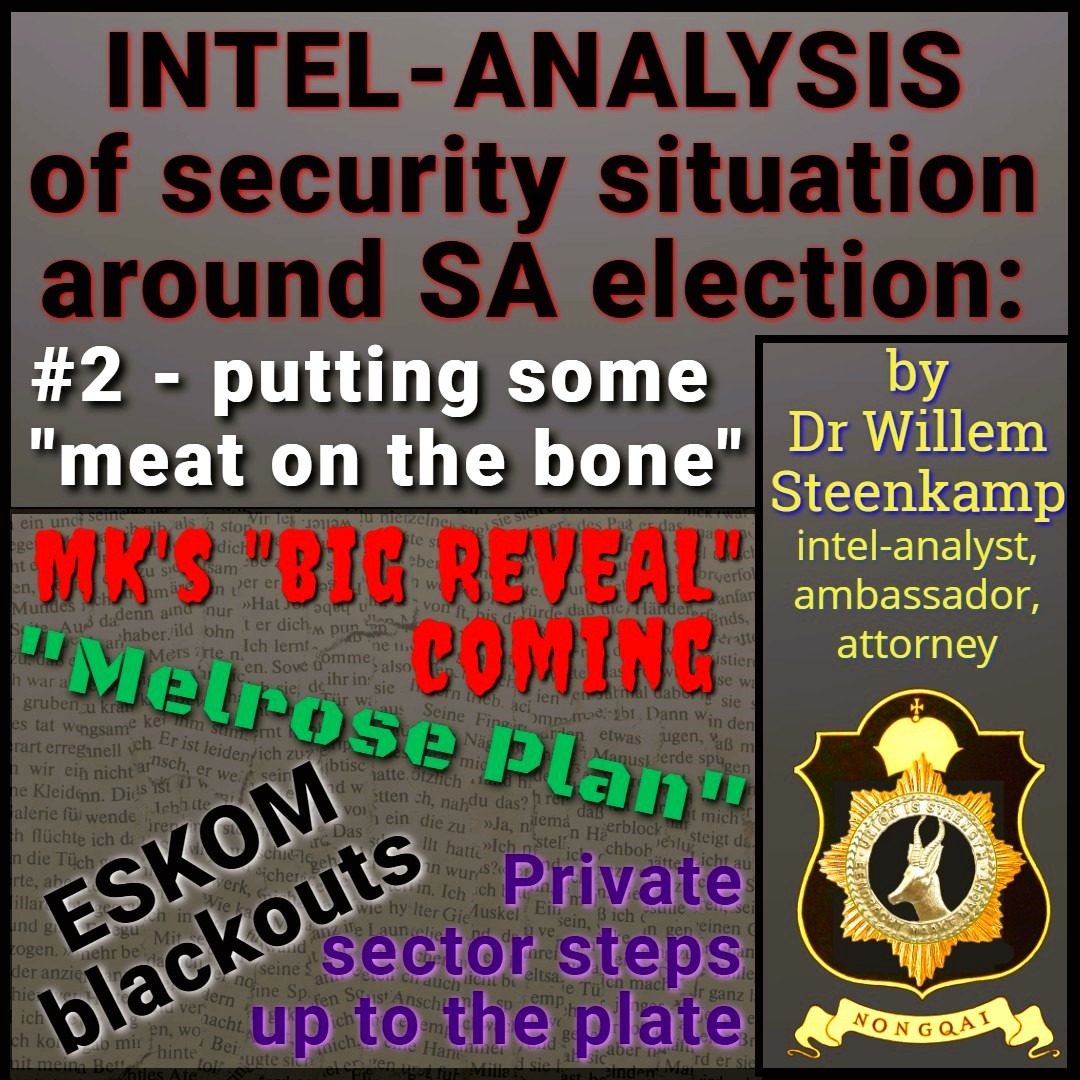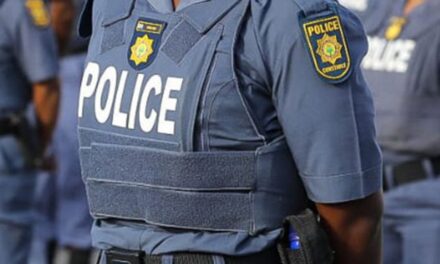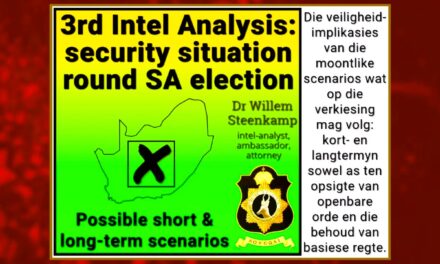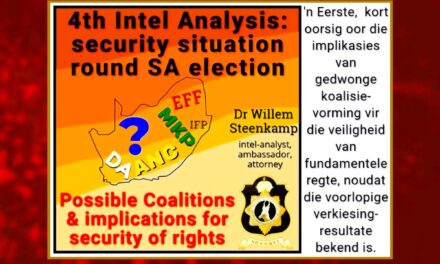ABSTRACT: Intel Analysis #2 security situation round SA Elections – our second intelligence analysis of the national security situation likely to pertain just prior to, and especially in the aftermath of the 2024 South African general elections; it shows that there is reason for guarded optimism, particularly because government (as well as business and civil society) will not be caught unawares this time, thanks also to the way in which private sector intelligence is now contributing to ensure informed decision-making. Whereas the first analysis had filled in the hitorical background, this analysis puts some “meat on the bone” regarding information underpinning the evolving intelligence picture – aspects such as the Zupta “Melrose Plan”, ESKOM sabotage, and MK’s “Big Reveal”.
FOCUS KEYWORD: Intel Analysis #2 security situation round SA Elections
KEYWORDS: South African general election 2024, Cyril Ramaphosa, Jacob Zuma, MK Party, ANC, EFF, Operation Vula, Bheki Cele, SSA, ASAS, Melrose Plan, ESKOM.
AUTHOR: Dr Willem Steenkamp (retired intelligence analyst, ambassador, lawyer, co-editor Nongqai SA Forces History Magazine).
INTEL ANALYSIS #2 SECURITY SITUATION ROUND SA ELECTIONS - putting some "meat on the bone"
OUR FIRST ANALYSIS WAS A GENERAL BACKGROUNDER
Our first analysis on how the security situation in the country could evolve around the upcoming South African election was done about a week ago (read it here: https://nongqai.org/intel-analysis-security-situation-round-sa-elections/ )
It aimed to provide a broad overview of the security situation and its roots. The goal was to place the current security scene in historical context. Also, to highlight the driving forces and considerations that would impact how the security scenario around the 2024 South African election would likely play out – especially during the period of (likely) coalition forming immediately after the election, should no party achieve an outright majority.
The conclusion was (and remains) that the general pointers that we do have, make it prudent to “pray for the best but plan for the worst”. Contingency preparations out of an abundance of caution, thought through soberly and calmly. This recommendation is based on incontrovertible indicators from history, such as the events of July 2021, plus the ideological attachment of erstwhile revolutionary forces to concepts such as that “power grows from the barrel of a gun”, as well as the undeniable track record of the likely “disruptors’” of having indeed planned schemes such as Operation Vula, not that long ago.
Again, one should not take a repeat of July 2021 as a definite certainty. Far from it, actually – as this 2nd analysis will substantiate. Contingency preparation is best done without succumbing to paranoia or vigilantism. The last thing now needed is for our complex society to be further polarized by contingency preparations done on an “us and them” basis, driven by prejudice rather than cool, reasoned thinking.
THIS ANALYSIS DIVES DEEPER INTO CURRENT INFORMATION
With the background sketched in that first analysis, it is opportune now to dive deeper and analyse what has changed since July 2021, and what remains broadly the same. To “put some meat on the bone”.
The past week has brought to the fore further developments and information (practically all of which are quite positive in nature) which need to be analysed and factored into the overall risk assessment, in order to have a balanced picture.
That said, one should always keep in mind that life has, since the dawn of time, been highly unpredictable. The “best-laid plans of mice and men” do go awry, particularly if command and control isn’t that strong. Especially also since South African society is notoriously combustible, driven often by emotion and local events that then spread, with very many actors and factors potentially impacting it – often seemingly from out of the blue. That inherent uncertainty is why the core assessment remains the same – namely, that it remains prudent to be prepared.
However, what the emerging picture does indicate, is that a carbon copy of the July 2021 unrest and looting is probably avoidable. The thrust of the coming politicking is likely going to be directed down other paths.
WHAT HAS REMAINED THE SAME SINCE JULY 2021?
Much the same faces
The key protagonists and cast of supporting role-players are still broadly the same now as in July 2021. Essentially the Zuma faction versus the Ramaphosa faction. (But, as we shall show, the circumstances surrounding them, the operational environment, as well as the stakes for which is to be played, have significantly evolved).
The same guiding strategic considerations still apply
What has remained fundamentally the same (as the underlaying guiding reality regarding limited viable strategic choices, particularly for the governing side), is the fact that no black government can afford to fall into the trap of another Marikana – that is to say, to act so forcefully against black rioters and looters that it leads to a significant number of deaths.
Conversely, it remains one of the primary goals of insurrectionist elements to try and entice the government into just such a trap, because they know that another Marikana would politically be the beginning of the end for the government as currently constituted.
The above fundamental considerations have not changed, making it unlikely (and evidently unwise) for government to have as its main counterstrategy to try and simply suppress unrest by means of brute force. No-one should therefore have the expectation, nor adhere to the idea, that massive force alone would be a solution, or indeed should be resorted to.
Which is not to say that a show of force has no place as means of dissuasion, or that rampant lawlessness should simply be allowed to spread un-checked (we will come to necessary preparations regarding adequate force deployments and readiness, a bit later in this assessment).
What has, unfortunately, stayed much the same is the widely perceived dysfunctionality of the SSA, the State Security Agency, which is negatively impacting the state’s ability to collect and assess relevant intelligence in a timely manner. It will be recalled that President Ramaphosa had explicitly stated to the Human Rights Commission investigation into the 2021 unrest, that the SSA had provided no prior alerts about it.
This dysfunctionality still persists – the SSA has, for example, been without a DG since end November 2023.
However, as I will show in this analysis, that void has been significantly compensated for by welcome initiatives from the side of the private intelligence sector – inputs that are positively aiding government’s informed decision-making. (Enumerating and assessing these positive developments will form the core of this 2nd analysis).
This is first and foremost a contest for political power, with unrest merely a lever
What was said above about the underlying strategic consideration (i.e., avoiding Marikana-type tragedies) illustrates the importance of seeing the situation for what it truly is – namely, a political conflict at heart, not merely a law-and-order issue. For the “insurrectionists” unrest is a tool, and not a goal in itself. It must be understood that any government will always respond firstly in terms of its own political imperatives, which may differ from the interests of the general public.
Which is what makes well-informed planning at community level, ensuring adequate preparation for properly-executed as well as appropriately calibrated contingency measures (designed to ideally prevent trouble), so important.
WHAT HAS CHANGED SINCE JULY 2021?
Two key 2021 determinants are no longer present
Even though the above-mentioned constraint against massive use of force has remained the same, two very important determinants of how and why things happened as they did in 2021, are no longer present.
The first determinant which in July 0f 2021 still played a significant role but which now no longer exists, is the intra-ANC political constraint that stemmed from the then reality that former president Jacob Zuma at that time was still a senior leader of the governing party itself, revered by almost half of the ANC. This meant that the Ramaphosa government in 2021 was inclined and bound to handle the situation that erupted with kid gloves, reactively at that.
Now, because of the fact that Mr Zuma has chosen to throw down the gauntlet by breaking away and forming an opposing political party, those constraints are gone. We can already see the gloves coming off…
The other factor is the element of surprise. July 2021 had seemingly come out of the blue and had caught government, organised business, communities, and individual citizens alike, unprepared. This time round the government of the day is very much aware of the potential threat to national security and is actively preparing to try and avert it, and/or to meet it, if it should in fact appear to start simmering again.
There is no doubt that the most direct cause of the unrest and destruction of July 2021 occurring as it did, was the lack of awareness and consequently lack of preparation, on the part of government – but also on the part of organised business, communities, and individual South Africans living in flashpoint areas.
An aware and better prepared government
This new awareness and commitment to proper preparation among government institutions is especially true of the SAPS, but also the SANDF. These institutions are now capable of reacting much faster and much more efficiently, with contingency plans already in place for every locality.
Another important difference is that this time round, the top structure of the security forces is no longer “infiltrated” by senior officers sympathetic to the “insurrectionist” side. This is particularly so in the case of the SAPS, which has been “purified” by the Ramaphosa government.
In key areas, such as KZN, the competency and capacitation of commanding officers has also been much improved. It is being planned to deploy 17,000 additional police officers to KZN, from different parts of the country – a huge “surge” which should have both a dissuasive effect and ensure adequate capacity if things do go wrong in certain localities there. (The world over it is a recognised principle of POP – public order policing – that such specialist contingents should purposefully be deployed away from their own home areas, so as to avoid fear of potential victimisation of their families and/or local biases influencing their execution of orders).
CIVIL SOCIETY AND THE PRIVATE SECTOR ARE ALERT AND ENGAGED
A very significant difference as compared to July 2021, is the awareness, preparation, and cooperation on the part of civil society and of the private sector.
Communities and the public mood
Many communities have drawn up community security contingency plans (having availed themselves of expert advice) and are now organised to help protect their own interests.
Regarding communities, it is also highly significant that the vast majority of traditional leadership (chiefs and hostel indunas) are making it pre-emptively clear that the kind of unrest seen in July 2021 should be avoided.
Judging by social media chatter (as scientifically monitored and analysed) there is also little appetite for a repeat of July 2021 among the general black population, who have seen and experienced for themselves the very negative consequences it had visited upon their own communities – with 660,000 jobs lost between Q2 and Q3 of 2021, local shops gone, and infrastructure destroyed.
The private sector helping to fill the voids
Perhaps the most impactful difference regarding the capacity for informed decision-making by government and its institutions, relates to what the private sector can and is contributing. This is due to heightened willingness on the part of private sector entities to contribute the open-source operational data that they have at their disposal, into the national intelligence data pool.
Fortunately, this is paralleled by a heightened understanding on the part of key government decision-makers in the Security Cluster regarding the importance and utility of such private intelligence data, leading to a much greater receptiveness towards accepting and using it.
Why are private intelligence professionals doing this? It is obvious that events such as those of July 2021 greatly harmed the private sector materially, whether it be through loss of buildings and plant, or through loss of business on the part of the likes of taxi associations. Of course, pure patriotism and good citizenship also plays a role.
It is important that the public also has a balanced understanding of what this kind of private, open-source intelligence is and the role it can play. Comprehending what these inputs are and can do, should help to bring balance to somewhat exaggerated threat perceptions current among many of the public.
This can best be done by means of two things: firstly, by sharpening public understanding of what such privately sourced intelligence actually is (being open-source data derived from normal business operations, but which can do much to help avoid a repeat of July 2021).
Secondly, and very importantly, by making the public aware of the fact that the essential intelligence input required by government is in fact reaching key decision-makers in a properly structured manner.
I hope that the positive information about this important asset now impacting government’s preparedness for dealing with any potential insurrectionist unrest (as will be shared with you now in this analysis), will help temper paranoia and avoid overblown fear, whilst also making clear to prospective insurrectionists that, this time round, nobody is going to be caught unawares…
What is the nature of the private intelligence being made available?
It is important to clarify at the outset what kind of intelligence input the private sector is contributing (channelled to the SAPS by means of some of the very competent private intelligence professionals operating in the country). This isn’t so-called “secret intelligence”. It doesn’t derive from spying on individuals, illegally tapping communications, or any such kind of covert activities.
It should be understood that, the world over, around 90% of the daily stream of information being in-put into any nation’s intelligence process (converting raw data into evaluated, interpreted, and contextualised intelligence output) derives from open sources.
To give an example that’s very relevant to the type of thing that occurred during the July 2021 unrest, when cell-phone towers were targeted: obviously, the companies owning and operating those towers have computerised systems in place monitoring their towers in real time. The same applies to operators of fibre-optic cables, wifi hotspots, toll booths on main trunk roads, essential infrastructure such as water and electricity, and so I can carry on.
All business management is nowadays computer-based, and inter-linkable via the internet. All enterprises need to generate such data for their own internal use, as the basis for sound management of their businesses.
Now imagine all of these some 7,600 data points from all across the country, from all relevant business sectors, being centrally monitored and fed into a computerised “Alert Safe Analytics System” (ASAS) in a coordinated manner, processing and aggregating it continuously in real time – even being capable of graphically displaying it all in inter-related form on screen, overlayed with maps and the like.
This is exactly what professional private intelligence is nowadays making available to the likes of Minister of Police Bheki Cele – and part of the good news is that these professionals deem him very competent indeed at understanding and appropriately valuing and acting upon this input.
Again, this is not based on illegal spying or dodgy intercepts, but rather on the advanced computing capabilities (in terms of appropriate software and high-capacity data processing infrastructure) available in the private sector for normal day-to-day business operations, allowing the real-time aggregation and interpretation of this open-source information.
A vital supplement to the kind of situational data referred to above, is the expert monitoring of social media traffic, which again is open source (and which the owners of such platforms are in any case by law obliged to monitor, to weed out things like child porn).
Again, with the right ASAS-type software and associated powerful computing capabilities, it is possible to scan the huge stream of chatter on social media for indicative keywords, which would signal planned unrest, public mood, and tendencies down to the granular level of where and when “flash mobs” are being planned to erupt, for example. This, too, is being done and is being made available to government.
Lastly, it is self-evident that different sectors of private enterprise do possess, by the very nature of their business, vast networks of “eyes and ears” on the ground, across the length and breadth of the country. Think of the approximately 292 private security companies. Or the taxi associations.
By designing an ASAS capable of tapping into these networks as well, a massive, properly structured, extremely valuable flow of aggregated and processed open-source information is currently reaching decision-makers.
It is thus no wonder that, over the course of the past week, a number of media reports emerged (such as written by Carol Paton, or Charlie Robertson tweeting on the SA investment conference held in London) indicating that the South African private sector is not hugely stressed out about what the election may hold – at least not in their public posturing…
Dissuasive messaging
I have mentioned earlier that the constraints which applied in 2021 because of Mr Zuma then still being a member of the ANC, have now fallen away due to him forming an opposing party.
I have it on good authority that this has now resulted in clear messaging to the Zuma side that inciting insurrection will lead to significant consequences.
Mr Zuma’s daughter is on record as having publicly stated that the Nkandla homestead (which allegedly is close to Mr Zuma’s heart) serves as their headquarters. An example of just such kind of messaging allegedly being passed on, is that this public statement on record would hypothetically allow for obtaining a search warrant and potentially a raid on Nkandla, if insurrection again is instigated – a raid not by regular cops but by specialist forces…
The “Melrose Plan” – what (allegedly) is it about?
Of course, such messaging works both ways and can also heat up the atmosphere considerably – it is said to be clear from chatter that the MK party is planning a “big reveal” of allegedly sensitive “personal secrets” from the recent past, which would discredit and politically harm President Ramaphosa and his key supporters within the ANC. This is allegedly planned for when parliament reconvenes.
These happenings are viewed as being inspired by the so-called “Melrose Plan” (so named because it was developed at the Melrose Place offices of the Guptas in 2019). It is the “soft option” plan for re-acquiring political power, being of a parliamentary political nature (i.e., not a “hard option” insurrectionist coup). This plan was developed to try and bring the Zuma faction back to power, replacing the Ramaphosa faction.
What it entails, is a strategy for bringing the Ramaphosa-led ANC down to below 50% of the seats in parliament, so that it will need a coalition partner to govern – which partner the Zuma faction (MK) then hopes to be, in a “tail wagging the dog” scenario. It should be understood that the ANC/MK contest is NOT in reality a contest between two opposing political parties (as in a classical two-party system), but at its core is an intra-family fight about control over the “broader ANC” (i.e., the combined Zuma/Ramaphosa factions).
This is exactly why Mr Jacob Zuma is so insistent that he still is and wishes to remain a registered ANC member, and why he is proclaiming at his public meetings that he continues, in heart and soul, to be ANC – with the creation of MK as party, just a tactical legal necessity in his struggle to take back the ANC from the interloper Ramaphosa who achieved the leadership thanks to and on behalf of WMC (White Monopoly Capital).
Which also explains why the Ramaphosa faction dearly wishes to have a disciplinary hearing to formally expel him from the ANC – the fact that they have thus far not been able to progress that, may be indicative of significant residual support remaining within the Ramaphosa ANC for Mr Zuma.
What is evidently being aimed for (again, if the Ramaphosa ANC can be brought below 50%) is to arrive in parliament in a position to say to the “ANC family” that, together, they can govern – but only on condition that the reins be handed back to the Zuma camp. It is a certainty that the overriding ambition of every ANC parliamentarian will be to hold the power of government, come what may – because on that depends the ability to allocate lucrative positions.
The prerequisite for success with such a strategy is of course that the Ramaphosa ANC needs first to be brought to below 50% of the popular vote. This would partly be achieved through syphoning off existing ANC voters (on the basis of traditional allegiance to the Zuma faction) to the new MK party. But essentially it needs to be achieved through elevating public frustration with the governing party, on the basis of service delivery failure. With electricity availability being the most potent issue.
ESKOM thus became a target, and undeniably the power blackouts of the past few years have had the effect of alienating many voters – understandably so. My purpose here is not to go into the myriad why’s and wherefores’ of ESKOM’s woes.
What is relevant to share here, is that the capability of private sector intelligence for processing and analysing massive data sets has recently made it possible to identify certain tell-tale patterns behind the disruptions in power supply, which could then be related back to certain contractors in key spheres.
These were found to be contractors whose controllers, upon investigation, had demonstrable past ties to the Zuma camp as well as records of having engaged in “soft sabotage” elsewhere (most readers will likely remember how regularly Mr André de Ruyter had attributed ESKOM’s difficulties in large part to deliberate sabotage).
It appears that, since these contractors were replaced some three months ago, operational performance has been mostly normalised (also thanks to the solar capacity that homeowners and businesses have installed). It is to the elimination of sabotage that the fact that blackouts have recently been avoided, has been largely ascribed by people believed to be in the know.
(I myself had initialled assumed that it was due to non-stop burning of diesel with the OCG Turbines, but actual figures of diesel consumption – which are hard to fudge – from ESKOM’s operations centre backed up by NERSA, seem to belie this notion, if the figures are indeed true).
Should the Ramaphosa ANC not achieve 50% of the vote (and it should be noted that tracking polls show the ruling party to be inching back to that level, being currently at around 47% and trending up) then of course the scene will shift to parliament. As said, the Melrose Plan then takes aim at influencing the “ANC family” of MP’s (ANC + MK) to oust the Ramaphosa faction and hand control back to the Zuma faction (that is, on the assumption that the two “parties”, or rather factions will, combined, than hold a clear majority of seats.
The “arguments” that will then be employed by the Zuma side, will be four-fold:
- If you don’t go with us, your life-long brothers and sisters, then you’ll have to go with the likes of the EFF or some other fringe parties, and then be beholden to them as king-makers;
- You’re in this position because of the failure of the Ramaphosa leadership to maintain the ANC in its traditional dominance – get rid of him;
- Sweeteners will be offered; and
- Threats of exposure of past “indiscretions” will be made (the coming “Big Reveal”) in order to sway some, and sideline others.
This will tap into an ever-present reality in any large party, namely that there are just so many positions available to be filled. Consequently, there are always many who believe that it should now be “their turn” and who surmise that the current leadership may be inclined to keep denying them, in order to carry on surrounding themselves with their own favourites. Thus, there is a natural inclination on the part of those not favoured, to see a change in leadership as an opportunity for own possible advancement.
As regards sweeteners being offered, it will not only be positions. In the horse-trading that is likely to mark the first parliamentary session (should the Ramaphosa ANC not have gained 50% of the vote) money is likely to play an important part. It is alleged by people in the know that the Guptas are still very much engaged, with data available on flights involving cash, Switzerland, and the Central African Republic.
It is also rumoured that two members of the IEC are beholden to the Zuma camp, with concern that they may potentially be prevailed upon to act as disruptors.
What is already clear from chatter (and which underpins the “Big Reveal” part of the updated Melrose Plan), is the role of threats of exposure as part of the carrot and stick strategy. It is a two-handed approach, with the financial incentives (positions/money) being the carrot, and the threat of exposure of past wrong-doing the stick.
It is assumed by observers that the recent action to unseat the former Speaker, was undertaken as demonstration and message as regards the ability to do just that to anyone in the hierarchy. To make the threats work optimally during the horse-trading phase, the ability to do so had to be concretely demonstrated beforehand. Removing the former Speaker did not bestow any legal-technical or procedural advantage, since the current Assembly becomes legally extinct already on 21 May, and since she was in any event not going to be available for re-election. It was therefore not constitutional positioning that motivated that trigger being pulled. What forcing her resignation by means of such a “reveal” did, was to send the message that even some-one as high up as she, could be brought down.
As regards Mr Ramaphosa, further revelations regarding Phala-Phala are allegedly in the pipeline… (the strategy being, to swing the ANC parliamentarians into teaming up again with the Zuma faction in order to have a majority, but with the Ramaphosa faction sidelined – quite possibly by using parliament’s own inherent power to decide who qualifies to be sworn in as members, no matter whether initially they were on a candidate list or not). It will be remembered that the key battles fought at recent ANC elective conferences, had been precisely about credentials and who would legally be seated as electors…
It is alleged that the Melrose Plan identifies a list of key Ramaphosa supporters to be “taken out” by means of such “big reveals”. One of them is said to be Minister Bheki Cele. As regards the judicial branch, it is being whispered that Minister Ronald Lamola is about to be specifically targeted with revelations as well. It should be remembered that the term of the current Chief Justice ends at the end of August, after which judge Maya will be sworn in as chief justice – it is believed by observers that her natural sympathies may tend towards the Zuma/EFF philosophical positions.
All of the foregoing is clearly speculative but should nonetheless be taken note of as being actually chatter doing the rounds.
What it does demonstrate, though, is that getting into parliament is at this time the Zuma camp’s overriding necessity and thus principal objective (i.a., because it will provide them with the immunity for launching their “big reveal” without risk of legal action).
In this, the question of whether Mr Zuma is allowed to feature on MK’s list is not fundamental – which makes it likely that they will choose to keep their powder dry for the moment, even should the ConCourt’s upcoming decision go against Mr Zuma’s inclusion on the MK list.
Conclusion
The mostly positive information above is shared not to suggest that everything around the election will pass as if on a bed of roses. However, since this positive appears real (at least in the sense of being things that are being said) it evidently needs to be taken note of; hopefully it will also help to counterbalance some of the fear and paranoia that one sees in certain corners of cyberspace.
On the other hand, the fact that the gloves are now off, in and of itself can lead to things becoming heated quite quickly.
It is also obvious that very much more is at stake this time round, than was the case in July 2021 – which could lead to greater emotion on the part of supporters as well as a willingness to greater risk-taking on the part of politicians who see all to play for.
In the wider and more lasting context, when considering the long-term security and prosperity of the nation, it also seems valid to postulate that the greatest risk in reality lies in the formation of a coalition with potentially destructive policies. If moderate politicians don’t maintain clear heads and unemotional hearts, then such a destructive coalition could emerge almost by default from the cajoling and strong-arming that’s likely to follow upon an inconclusive election.
Such a coalition taking power would be much more lastingly negative than even a repeat of 2021-style unrest – no matter how destructive and murderous that was… (remember, unrest is just a tool for achieving political ends).
The ConCourt issuing its judgement, soon, on Mr Zuma’s candidacy will likely give an early indication about the mood among his supporters and to what extent they are disposed to engage in disruption (if the decision should indeed go against him).
MK being a new movement which clearly is still in flux, with questionable control over its supporters (many of whom have demonstrated themselves to be somewhat excitable) emotion-driven localised flare-ups cannot be ruled out when the judgement is handed down, even if not directly ascribable to orders from the party’s hierarchy.
Therefore, it remains prudent to “hope for the best but plan for the worst”, doing so as early as possible (but always calmly and rationally, based upon proper information).










Trackbacks/Pingbacks